Nicola Cornick's Blog, page 6
October 25, 2013
Every House tells a Story
It’s been a busy few weeks here. First I have been trying to make progress with Claimed by the Laird, book 3 in the Scottish Brides series, which is out next summer. The final book in the  trilogy, Claimed by the Laird is Christina and Lucas’s story and I’m having a lot of fun writing it!
trilogy, Claimed by the Laird is Christina and Lucas’s story and I’m having a lot of fun writing it!
Then I had a talk to prepare for the Wantage Literary Festival on the inspiration Jane Austen took from her friends and members of her family in the building of her characters. I think people enjoyed the talk and the Jane Austen Day at the festival was great fun!
However I did manage to play truant one day and slipped away to visit the beautiful Snowshill Manor in the Cotswolds. Every house has a story to tell and at Snowshill the story is all about Charles Wade, the eccentric collector who filled the house with a range of objects he had started to collect from the age of seven. Wade was an architect by training and a talented painter and draughtsman as well. An inheritance from a sugar plantation in St Kitts meant that he did not have to work for a living but could indulge his passion for design in whatever project he chose and also that he could travel widely to collect all manner of objects that interested him. He and his friends also had a penchant for dressing in 18th century costume!
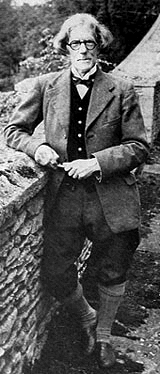 Each room at Snowshill is packed with beautiful objects, from musical instruments of the 18th and 19th century to Balinese masks and Indo-Persian shields. Each room is also given a special name to denote its position in the manor house or the type of collection it houses. “Admiral” has nautical and scientific objects. ”Mermaid” reflects Wade’s upbringing by the sea in Great Yarmouth. “Seventh Heaven” contains toys and nursery items. “Dragon” is named for the huge open fire. The names are as quirky as the objects themselves. Wade and his wife did not actually live in the house itself. It was kept entirely as a place to display Wade’s collection whilst they lived on a cottage on the estate in fairly primitive conditions. Modern plumbing and electricity were not encouraged!
Each room at Snowshill is packed with beautiful objects, from musical instruments of the 18th and 19th century to Balinese masks and Indo-Persian shields. Each room is also given a special name to denote its position in the manor house or the type of collection it houses. “Admiral” has nautical and scientific objects. ”Mermaid” reflects Wade’s upbringing by the sea in Great Yarmouth. “Seventh Heaven” contains toys and nursery items. “Dragon” is named for the huge open fire. The names are as quirky as the objects themselves. Wade and his wife did not actually live in the house itself. It was kept entirely as a place to display Wade’s collection whilst they lived on a cottage on the estate in fairly primitive conditions. Modern plumbing and electricity were not encouraged!
I have never been anywhere quite like Snowshill; I found the sheer size and variety of the collection overwhelming and after a while I simply could not take it all in. I also found that the amount of “stuff” in the rooms meant that I couldn’t always see the architecture, which was a shame because Snowshill incorporates elements from the medieval period through the Tudor and 18th century and is stunningly beautiful. What Snowshill had in spades was atmosphere. I didn’t feel quite comfortable there. I’m not familiar with any ghost stories relating to the house but I wouldn’t like to be locked up there on my own at Halloween! It was the sort of house and the sort of experience that I couldn’t talk about for half an hour afterwards because I was completely overwhelmed by it. What an amazing place. Glorious gardens too. All in all, well worth a visit.
©2013 Nicola Cornick. All Rights Reserved.
.October 11, 2013
Apple Day!
As you know I like to look into the history of almost anything on this blog and today (over at the Word Wenches) I am talking about the not-so-humble apple, and what it has done for us.  Growing wild in Neolithic times, introduced as a cultivated fruit by the Romans and the source of theft and rivalry in Regency England, the apple has a vivid history! Drop by the Wenches to talk fruit with me!
Growing wild in Neolithic times, introduced as a cultivated fruit by the Romans and the source of theft and rivalry in Regency England, the apple has a vivid history! Drop by the Wenches to talk fruit with me!
©2013 Nicola Cornick. All Rights Reserved.
.October 8, 2013
Queen Victoria’s Wedding Shoes
Okay, I’m cheating! I was meant to be posting up a new blog piece today but I am so engrossed in the final book in my Scottish Brides series that I ran out of time. So I decided to post up a 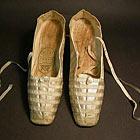 picture of shoes instead! I love browsing the costume museums and studying the shoes. Here are Queen Victoria’s wedding shoes from 1840. These beautiful satin slip on shoes were made by Gundry and Sons of London. Victoria had nine inch feet and the shoes are approximately a size 3. They are trimmed with six bands of ribbon and a small bow, with a leather sole and no heel. This style was very fashionable in the period.
picture of shoes instead! I love browsing the costume museums and studying the shoes. Here are Queen Victoria’s wedding shoes from 1840. These beautiful satin slip on shoes were made by Gundry and Sons of London. Victoria had nine inch feet and the shoes are approximately a size 3. They are trimmed with six bands of ribbon and a small bow, with a leather sole and no heel. This style was very fashionable in the period.
It was not the done thing for ladies to to show their feet in this era and so they often wore shoes that were too small to make their feet as inconspicuous as possible (although if you were hobbling around in too-small shoes you would probably draw attention to your feet rather than hide them!) Queen Victoria’s feet, small as they were, were often painted to look even smaller!
Information and picture courtesy of Northampton Museum and Art Gallery, licensed under the creative commons licence. Thank you!
©2013 Nicola Cornick. All Rights Reserved.
.October 4, 2013
Hot History Boys!
Last week when I was taking a tour group around Ashdown House they fell to discussing our portrait collection, specifically which of Elizabeth of Bohemia’s daughters was the best looking.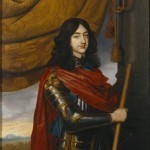 Now I don’t have a problem with this in the sense that I find the changes in standards of beauty over the centuries an interesting academic subject. Personally I don’t care for the opulent beauties of the Restoration court, and how many of us would have been feted at Almacks for our stick thin, blonde Regency good looks? Fashions in looks are a fascinating thing.
Now I don’t have a problem with this in the sense that I find the changes in standards of beauty over the centuries an interesting academic subject. Personally I don’t care for the opulent beauties of the Restoration court, and how many of us would have been feted at Almacks for our stick thin, blonde Regency good looks? Fashions in looks are a fascinating thing.
 At Ashdown, for example, we tell visitors that Elizabeth’s eldest daughter (another Elizabeth) was considered the greatest beauty of the age and was known as “the Star of the North.” Elizabeth herself was no slouch in the looks department being known as the most charismatic and beautiful princess of her generation. What is interesting is that our modern day visitors almost never agree; it’s always another of the girls whom they think is the most beautiful.
At Ashdown, for example, we tell visitors that Elizabeth’s eldest daughter (another Elizabeth) was considered the greatest beauty of the age and was known as “the Star of the North.” Elizabeth herself was no slouch in the looks department being known as the most charismatic and beautiful princess of her generation. What is interesting is that our modern day visitors almost never agree; it’s always another of the girls whom they think is the most beautiful.
Well, looks aren’t everything but in the interests of levelling the score, however, I have to ask – what about our history boys? At Ashdown we are blessed with a collection of handsome Stuarts. Handsome, that is if you admire the distinctive, dark, melancholy looks of the Stuart family. Ladies – and a few gentlemen – have been known to swoon over our Prince Rupert portrait. So as it’s Friday I thought I would post up a few of our hot history boys and ask you what you think. First we have, top right, King Charles II, left, Prince Edward Palatine (said to be the easy-going and fun one) and bottom right Prince Rupert (explosive temper, reckless, but probably worth it.)
temper, reckless, but probably worth it.)
Are you a fan of the Stuart looks? Which gentleman takes your fancy? Perhaps you have your own favourite history hunk? And do you think that modern standards of beauty/good looks differ greatly from those admired in the 17th century? First comment drawn out of the hat on Monday wins a book – if not dinner with Prince Rupert.
©2013 Nicola Cornick. All Rights Reserved.
.September 30, 2013
The Wild West!
This is Torridon, one of my favourite parts of Scotland. It’s an area in the North West Highlands with the most stunning scenery imaginable, mountains like fortresses and beautiful sandy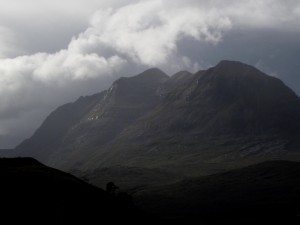 beaches, ruined castles and glens full of the purple and gold of heather and bracken. I’ve been visiting Torridon for many years and it features as the setting for Methven Castle in One Night with the Laird, Book 2 in the Scottish Brides trilogy, which is out at the end of next month. In the story Mairi, the heroine and sister of Lucy in book 1, travels from Edinburgh (another of my favourite places – more on Edinburgh in another blog post) to her brother-in-law’s castle on the west coast. It’s a wild and rugged landscape – rather like the men in the series!
beaches, ruined castles and glens full of the purple and gold of heather and bracken. I’ve been visiting Torridon for many years and it features as the setting for Methven Castle in One Night with the Laird, Book 2 in the Scottish Brides trilogy, which is out at the end of next month. In the story Mairi, the heroine and sister of Lucy in book 1, travels from Edinburgh (another of my favourite places – more on Edinburgh in another blog post) to her brother-in-law’s castle on the west coast. It’s a wild and rugged landscape – rather like the men in the series!
The picture on the right was taken on the last day of our holiday. We had taken a flask of tea and some cake and climbed up to a viewpoint looking across to the mighty mountain Liathach. As you can see, it’s about to rain (a feature of the holiday!) The clouds sweeping up the glen made the entire view even more spectacular and atmospheric.
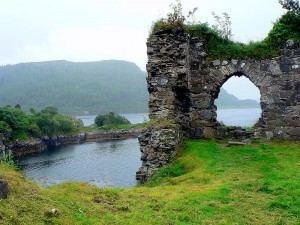 There aren’t many castles in the area where we were staying (other than the famous Eilean Donan) but one ruin we have visited many times on our travels is Strome Castle, originally built by the MacDonald Earls of Ross. In One Night With the Laird I have taken the liberty of making Strome no longer a ruin and it is the home of Mairi’s parents in law, Lord and Lady MacLeod. I’ve had to borrow a photo here because the day we visited Strome it was… Yes, you guessed it – raining! I do have a lovely photo of me sheltering with the dog under that very archway, though!
There aren’t many castles in the area where we were staying (other than the famous Eilean Donan) but one ruin we have visited many times on our travels is Strome Castle, originally built by the MacDonald Earls of Ross. In One Night With the Laird I have taken the liberty of making Strome no longer a ruin and it is the home of Mairi’s parents in law, Lord and Lady MacLeod. I’ve had to borrow a photo here because the day we visited Strome it was… Yes, you guessed it – raining! I do have a lovely photo of me sheltering with the dog under that very archway, though!
©2013 Nicola Cornick. All Rights Reserved.
.September 25, 2013
Meet Historical Honey!
Today on the Word Wenches we have an interview with the fabulous Historical Honeys! As a public historian I’ve been bowled over by the work that the Historical Honey site is doing to  make history fun and accessible to all. With their #SecretBookClub and passion for historical fiction they are a perfect match for the Wenches. Join us to find out what Historical Honey is all about. Naturally there is a fun quiz and a book giveaway as a prize!
make history fun and accessible to all. With their #SecretBookClub and passion for historical fiction they are a perfect match for the Wenches. Join us to find out what Historical Honey is all about. Naturally there is a fun quiz and a book giveaway as a prize!
©2013 Nicola Cornick. All Rights Reserved.
.September 20, 2013
Congratulations!
Many congratulations to Arizona, who wins the contest for a book from the lovely Anna Campbell! Thank you to everyone who commented on the interview. It was a huge thrill to have 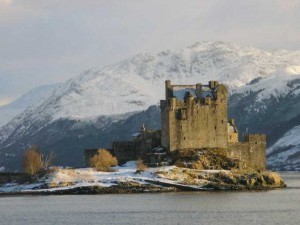 Anna as a guest here and your comments made it a lot of fun.
Anna as a guest here and your comments made it a lot of fun.
Belated congratulations as well to Lisa, who wins the August website contest. This month there are three copies of The Lady and the Laird on offer. Check out the contest here!
I’m just back form a fabulous trip to Scotland – there’ll be photos and history snippets next week here on the blog!
Happy weekend, everyone!
©2013 Nicola Cornick. All Rights Reserved.
.September 16, 2013
An Interview with the fabulous Anna Campbell!
 Today it is my very great pleasure to welcome acclaimed author Anna Campbell to the Passion for History blog. Anna is the multi award winning author of rivetingly passionate and emotional historical romance and an author whose books I have loved ever since the first one hit the shelves. She’s also a great friend and a lot of fun to have around! Anna, welcome to the blog!
Today it is my very great pleasure to welcome acclaimed author Anna Campbell to the Passion for History blog. Anna is the multi award winning author of rivetingly passionate and emotional historical romance and an author whose books I have loved ever since the first one hit the shelves. She’s also a great friend and a lot of fun to have around! Anna, welcome to the blog!
A Rake’s Midnight Kiss is the eagerly awaited second book in your Sons of Sin Series, following the brilliant Seven Nights in a Rogue’s Bed, which I adored. Please tell us about the story.
AC: Ooh, aren’t you lovely? Thank you! As you know, I devoured THE LADY AND THE LAIRD like a braw Scotsman devours a haggis! So this is clearly a mutual admiration society!
When I got the idea for A RAKE’S MIDNIGHT KISS, I wanted to write about a man who becomes a hero in spite of himself. Sir Richard Harmsworth is one of those witty, elegant, detached men who have learned to distrust emotion. Against his better judgement, he falls head over heels in love with virginal vicar’s daughter Genevieve Barrett who is the only woman who has ever seen through his charm to the real man underneath. He has to step up to the plate and put his heart on the line (and all the other clichés!) when he realizes Genevieve is in danger and only he can save her. You can read an excerpt on my website here:
NC: I love it when a hero who thinks he is immune to emotion falls hard and I loved the way that Richard met his downfall! Which was your favourite scene in the book?
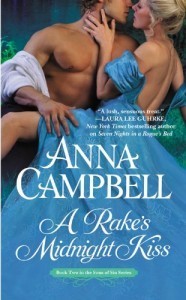 AC: Actually this one was great fun to write pretty much all the way. I got to tell a few jokes and I loved the way Richard and Genevieve keep snarking in the dialogue while it’s perfectly clear that they’re crazy about each other. If I had to pick a scene, I’d probably go for the rake’s actual midnight kiss – the title refers to a specific scene in the book. Richard discovers that Genevieve likes to swim naked in the moonlight and things spiral out of control from there. Or perhaps I’d choose the ending which always makes me cry – not a good thing when you’re trying to do a cold, hard edit! I love how that circles back to the opening of the story and we see how love has enriched Richard’s life and made him a better man.
AC: Actually this one was great fun to write pretty much all the way. I got to tell a few jokes and I loved the way Richard and Genevieve keep snarking in the dialogue while it’s perfectly clear that they’re crazy about each other. If I had to pick a scene, I’d probably go for the rake’s actual midnight kiss – the title refers to a specific scene in the book. Richard discovers that Genevieve likes to swim naked in the moonlight and things spiral out of control from there. Or perhaps I’d choose the ending which always makes me cry – not a good thing when you’re trying to do a cold, hard edit! I love how that circles back to the opening of the story and we see how love has enriched Richard’s life and made him a better man.
NC: Do you have a particular type of story you are drawn to tell?
AC: Oh, what an interesting question. Up until my last few releases, I would have said that all my stories are Beauty and the Beast in one way or another. But 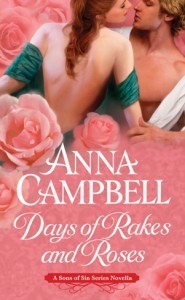 neither my e-novella DAYS OF RAKES AND ROSES nor A RAKE’S MIDNIGHT KISS falls into that category. Both Simon and Richard are charmers hiding their emotional turmoil behind a careless smile, rather than beastly loners like Jonas from SEVEN NIGHTS. Something I have noticed in all my stories is that questions of identity seem to proliferate. I was surprised to realise quite how many Anna Campbells involve someone using an alias! Through the adoption of a false identity, the characters end up working out who they really are.
neither my e-novella DAYS OF RAKES AND ROSES nor A RAKE’S MIDNIGHT KISS falls into that category. Both Simon and Richard are charmers hiding their emotional turmoil behind a careless smile, rather than beastly loners like Jonas from SEVEN NIGHTS. Something I have noticed in all my stories is that questions of identity seem to proliferate. I was surprised to realise quite how many Anna Campbells involve someone using an alias! Through the adoption of a false identity, the characters end up working out who they really are.
NC: What’s coming up next for you?
AC: I’m currently madly writing book three in the series, which is Cam’s story. Again, I’m having great fun with it. The alpha Duke of Sedgemoor who has had everything so together in the other books comes unstuck when he falls in love with a very unsuitable woman indeed. I love to watch Mr. Cool lose the plot – and in the process find his happy ever after!
NC: I can’t wait to read Cam’s story!
I know you are a big fan of British stately homes (and cream teas!) Do you have any particular favourites?
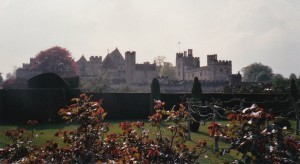 AC: Nicola, I still smile when I remember the Regency Writers Go Wild tour that we did around the Cotswolds in 2007. Didn’t we have fun? Stately homes and cream teas are a wonderful mix – throw in a decent giftshop and I’m in Nirvana. The National Trust does a wonderful job of preserving historical properties for people to enjoy, but I think my favourite houses are the ones where the original family still lives there. A couple of particular favourites are Penshurst Place in Kent and Haddon Hall in Derbyshire. Haddon Hall in particular is such a romantic place, it’s not surprising it turns up in every second costume drama including the recent BBC Jane Eyre.
AC: Nicola, I still smile when I remember the Regency Writers Go Wild tour that we did around the Cotswolds in 2007. Didn’t we have fun? Stately homes and cream teas are a wonderful mix – throw in a decent giftshop and I’m in Nirvana. The National Trust does a wonderful job of preserving historical properties for people to enjoy, but I think my favourite houses are the ones where the original family still lives there. A couple of particular favourites are Penshurst Place in Kent and Haddon Hall in Derbyshire. Haddon Hall in particular is such a romantic place, it’s not surprising it turns up in every second costume drama including the recent BBC Jane Eyre.
NC: We must do the Regency Writers Go Wild tour again sometime. It was awesome! There are some great choices there. I love Haddon too and always recommend it to people when they are visiting.
Who is your favourite fictional hero/heroine?
AC: I think my favourite heroine is Jane Eyre. I love that book and I admire her strength. She sticks to her idea of herself even when the going gets incredibly tough. My favourite hero is Dorothy Dunnett’s Francis Crawford who is the central character in her Lymond series set in 16th century Europe and the Middle East. Those stories are amazing. I’m due for a re-read but I know I’ll feel so inadequate as a writer once I do!
Dorothy Dunnett’s Francis Crawford who is the central character in her Lymond series set in 16th century Europe and the Middle East. Those stories are amazing. I’m due for a re-read but I know I’ll feel so inadequate as a writer once I do!
NC: Hmm, yes, there are some books that always leave me feeling wishful that I possessed the skill of that particular author! What are you currently reading?
AC: I’m catching up on a couple of contemporary romances that have been waiting patiently for my attention. I tend to hoard favourite authors until I can spare a few hours to concentrate on the books. On the top of the TBR pile at the moment, I have books by Sarah Mayberry, Liz Fielding and Annie West.
NC: What do you keep beside your computer when you’re writing?
AC: My cup of tea. I mainline the stuff while I’m working. Financial advice of the day – buy shares in Lipton!
NC: I can’t believe how many authors mainline tea! I’m another one who does; totally addicted! So if you weren’t a writer, what would you be?
AC: Very difficult to live with?
NC: That’s the best answer yet I’ve heard to that question! What’s the best writing advice you’ve ever been given and what advice would you give to other aspiring authors?
 AC: The best writing advice I was ever given sounds banal until you realise quite how profound it really is. At one of the first Romance Writers of Australia conferences I went to, I met romance writing legend Robyn Donald from New Zealand. She said, “The people who fail are the people who give up.” At that stage in my writing career that seemed obvious – of course I wasn’t going to give up. But then I spent a long time hovering on the verge of publication. It’s actually a much harder place to be than starting out. You’re doing the things you need to do to write a saleable book, including winning lots of contests and getting requests for material, but nobody’s taking that next step and buying your book. That’s the stage when you can get so frustrated that you’re tempted to stop. I’ve since seen many writers in exactly the same position and the wisdom of Robyn’s words strikes me anew every time.
AC: The best writing advice I was ever given sounds banal until you realise quite how profound it really is. At one of the first Romance Writers of Australia conferences I went to, I met romance writing legend Robyn Donald from New Zealand. She said, “The people who fail are the people who give up.” At that stage in my writing career that seemed obvious – of course I wasn’t going to give up. But then I spent a long time hovering on the verge of publication. It’s actually a much harder place to be than starting out. You’re doing the things you need to do to write a saleable book, including winning lots of contests and getting requests for material, but nobody’s taking that next step and buying your book. That’s the stage when you can get so frustrated that you’re tempted to stop. I’ve since seen many writers in exactly the same position and the wisdom of Robyn’s words strikes me anew every time.
My advice to new writers is to sit down and write a whole book, then put it aside for a while while you write something else before you come back to edit it. Writing a whole book will teach you things that nothing else can, including how to persist through the doldrums in the middle. Putting it aside will give you distance when it comes to picking out the flaws in your manuscript.
I’m going to steal a question from Nicola’s great list. Who is your favourite fictional hero or heroine? Why? I’ve got an international giveaway of a signed copy of A RAKE’S MIDNIGHT KISS for someone who comments today. Good luck!
A huge thank you to Anna for patiently answering all my questions and dropping in to the blog today! Here is the blurb for A RAKE’S MIDNIGHT KISS:
It Takes a Lady…
Brilliant scholar Genevieve Barrett knows how to keep a secret. Her identity as the author of her father’s academic articles has always been her greatest deception-until a charming housebreaker tries to steal the mysterious Harmsworth Jewel from her. She doesn’t reveal that she recognizes her father’s devastatingly handsome new student as the thief himself. For Genevieve, this will be the most seductive secret of all…
housebreaker tries to steal the mysterious Harmsworth Jewel from her. She doesn’t reveal that she recognizes her father’s devastatingly handsome new student as the thief himself. For Genevieve, this will be the most seductive secret of all…
..To Catch a Thief!
Sir Richard Harmsworth has been living a lie, maintaining a rakish facade to show society that he doesn’t care about his status as a bastard. Yet long haunted by his unknown father’s identity, Richard believes the Harmsworth Jewel will confirm his claim as the rightful heir. But when Richard sets out to seduce the bookworm who possesses the stone, he instead falls for its beautiful owner. But even as she steals Richard’s heart, Genevieve will be in greater danger than her coveted treasure…
To find out more about Anna and her fabulous books:
Website: www.annacampbell.info
Facebook: https://www.facebook.com/AnnaCampbellFans
Twitter: @AnnaCampbellOz
GoodReads: http://www.goodreads.com/author/show/296477.Anna_Campbell
Buy links:
Barnes and Noble: http://www.barnesandnoble.com/w/a-rakes-midnight-kiss-anna-campbell/1113742221?ean=9781455512102
Book Depository: http://www.bookdepository.co.uk/Rakes-Midnight-Kiss-Anna-Campbell/9781455512102
©2013 Nicola Cornick. All Rights Reserved.
.August 28, 2013
The Rush to the Border!
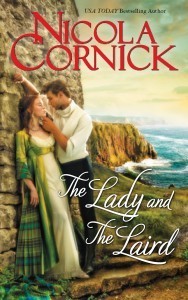 Elopement. It’s a major theme in Georgian and Regency romances. Like many people, I spent my teens reading the romances the Georgette Heyer and a number of my favourite stories had an elopement theme. These days the runaway match made at Gretna Green still frequently crops up.
Elopement. It’s a major theme in Georgian and Regency romances. Like many people, I spent my teens reading the romances the Georgette Heyer and a number of my favourite stories had an elopement theme. These days the runaway match made at Gretna Green still frequently crops up.
The tradition of English couples heading to Gretna in order to marry is rooted in Scottish law. Compared with their English neighbours, the marriage laws of 18th century Scotland were less strict. Girls aged 12 and boys aged 14 were able to marry without parental approval. By contrast, from 1753, England’s Marriage Act prevented couples under the age of 21 marrying without their parents’ consent.
In Scotland there was also no need for the reading of banns, or even the necessity of tying the knot in church, hence the fact that the Gretna village blacksmith was renowned as an “anvil priest.” Rather sweetly it was said that like the metals he forged, the blacksmith would join couples together in the heat of the moment, but bind them for eternity.
In fact the blacksmith was not the only person who could marry a couple. Under Scotland’s “irregular marriage” traditions anybody could carry out marriages whether they were the farmer, the blacksmith, the toll masters, or the landlord of the local tavern, a passing highwayman or the local smugglers.
It was not until the Lord Brougham Act of 1856 that the marriage laws were tightened. After that the couples were required to be resident in the parish for 21 days before the ceremony.
In The Lady and the Laird, Lucy and Robert take advantage of the fact that they do not need to have the banns read before they marry. Lucy’s brother Lachlan, whose elopement with Robert’s fiancée Dulcibella causes so much trouble, runs away to England with his bride, passing through Gretna Green on his way south from the Scottish Highlands in a reverse of what eloping couples normally did. (I thought this was funny – it never occurred to me when I made reference to it in the book that some readers would interpret it as Lachlan and Dulcibella eloping to Gretna to marry, rather than running away to England. The subsequent furore over my lack of research completely took me by surprise because I was looking at it as purely a geographical reference. My bad!)
 Speaking of geography, there is one thing that has always puzzled me about Gretna elopements. Runaway couples so often head off up the Great North Road to Scotland. This makes perfect sense if setting off from London or the eastern side of England. However a route like that would take an eloping pair via York to the Scottish border north of Berwick on Tweed and from there to Edinburgh, as the poet Shelley did with Harriet Westbrook, for example in 1811. The one place the Great North Road would not take you was to Gretna, which is, to coin a phrase, way out west. Author Louise Allen, who is an expert on stagecoaches and coaching routes comments:
Speaking of geography, there is one thing that has always puzzled me about Gretna elopements. Runaway couples so often head off up the Great North Road to Scotland. This makes perfect sense if setting off from London or the eastern side of England. However a route like that would take an eloping pair via York to the Scottish border north of Berwick on Tweed and from there to Edinburgh, as the poet Shelley did with Harriet Westbrook, for example in 1811. The one place the Great North Road would not take you was to Gretna, which is, to coin a phrase, way out west. Author Louise Allen, who is an expert on stagecoaches and coaching routes comments:
“Anywhere across the border would be OK although you had to be very, very careful with the Great North Road because of Berwick being in England. The toll keeper who usually did the weddings once they’d crossed out of Berwick’s boundaries into Scotland actually got sent to prison for performing the ceremony in Berwick town itself for one couple who arrived at the tollgate.” Clearly the English authorities were keen to stamp out this pernicious irregular act if the toll-keeper made the mistake of straying over the border!
In order actually to get to Gretna Green from London you had to take a left turn at Boroughbridge in Yorkshire onto a road that crossed the country from east to west. The picture shows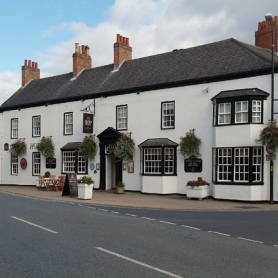 one of the coaching inns in Boroughbridge, The Crown. This route took the weary runaways to Penrith and from there to Carlisle and points north to Glasgow. So Gretna Green was not on the route from London to Edinburgh, nor was it necessarily the easiest or closest point at which an eloping couple could cross the border from England (unless they were coming up from Cornwall and the South West!)
one of the coaching inns in Boroughbridge, The Crown. This route took the weary runaways to Penrith and from there to Carlisle and points north to Glasgow. So Gretna Green was not on the route from London to Edinburgh, nor was it necessarily the easiest or closest point at which an eloping couple could cross the border from England (unless they were coming up from Cornwall and the South West!)
What Gretna does seem to have achieved was a reputation as being the pre-eminent place for anvil weddings. A case of very clever 18th and 19th century marketing, perhaps?
©2013 Nicola Cornick. All Rights Reserved.
.August 23, 2013
An Interview with Sarah Mallory!
Today at the Word Wenches we have an interview and giveaway with award winning historical romance author Sarah Mallory. Please do drop by to say hello and put you name in the hat for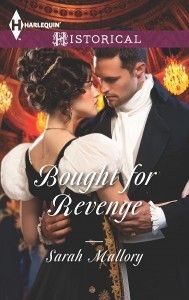 a copy of Sarah’s latest wonderful book, Bought for Revenge!
a copy of Sarah’s latest wonderful book, Bought for Revenge!
©2013 Nicola Cornick. All Rights Reserved.
.


